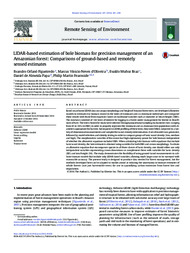LIDAR-based estimation of bole biomass for precision management of an Amazonian forest: comparisons of ground-based and remotely sensed estimates.
LIDAR-based estimation of bole biomass for precision management of an Amazonian forest: comparisons of ground-based and remotely sensed estimates.
Autoria: FIGUEIREDO, E. O.; OLIVEIRA, M. V. N. d'; BRAZ, E. M.; PAPA, D. de A.; FEARNSIDE, P. M.
Resumo: Based on airborne LIDAR data on canopymorphology and height of Amazon forest trees, we developed allometric models to estimate dry biomass stored in the boles of dominant and co-dominant individuals and compared these results with those from equations based on traditional variables such as diameter at breast height (DBH). The database consisted of 142 trees of interest for logging in a forest under management for timber in Brazil's state of Acre. The trees chosen for studywere selected through proportional sampling by diameter class (ranging from45 to 165 cm DBH) in order to properly represent the dominant and co-dominant tree populationswith diameters appropriate for harvest. Subsequent to LIDAR profiling of these trees, they were felled, subjected to a battery of dimensional measurements and sampled for wood-density determination. A set ofmodels was generated, followed by model selection and identity testing in order to compare groups of basicwood density (low, medium and high). The morphometric variables of the crown had high explanatory power for bole biomass independent of whether the allometric equations included DBH. When calculating bole biomass with equations that include basic wood density, the best estimate is obtained using variables for both DBH and crown morphology. To obtain an allometric equation that encompasses species in all three classes of basic density, one should either use only independent variables representing crown dimensions or complement these with variables for basic density (BD) and total height (Ht). The study demonstrates the feasibility of using ground-based measurements to calibrate biomass models that include only LIDAR-based variables, allowing much larger areas to be surveyed with reasonable accuracy. The present study is designed to produce data needed for forest management, but the methods developed here can be adapted to studies aimed at reducing the uncertainty in biomass estimates of whole forests (not just harvestable trees) for use in quantifying carbon emissions from forest loss and degradation.
Ano de publicação: 2016
Tipo de publicação: Artigo de periódico
Unidade: Embrapa Acre
Palavras-chave: Acre, Acumulación de materia seca, Amazonia, Amazonia Occidental, Amazônia Ocidental, Análise estatística, Análisis estadístico, Biomass production, Biomassa, Biomassa seca, Biometria, Biometria florestal, Bosques tropicales, Canopy, Computer software, Cubierta (plantas), Dry matter accumulation, Flora, Floresta Estadual do Antimary (AC), Floresta Tropical, Forest management, Geotécnica, Lásers, Manejo de precisão, Manejo florestal, Manejo forestal, Mathematical models, Matéria seca, Modelo matemático, Modelos matemáticos, População de planta, Producción de biomasa, Programa de computador, Programas de computadores, Raio laser, Remote sensing, Sensoriamento remoto, Sistema de Informação Geográfica (SIG), Sistema de Posicionamento Geográfico (GPS), Statistical analysis, Teledetección, Tropical forests, Western Amazon, lidar
Observações
1 - Por padrão são exibidas publicações dos últimos 20 anos. Para encontrar publicações mais antigas, configure o filtro ano de publicação, colocando o ano a partir do qual você deseja encontrar publicações. O filtro está na coluna da esquerda na busca acima.
2 - Para ler algumas publicações da Embrapa (apenas as que estão em formato ePub), é necessário ter, no celular ou computador, um desses softwares gratuitos. Sistemas Android: Google Play Livros; IOS: iBooks; Windows e Linux: software Calibre.
Acesse outras publicações
Acesse a Base de Dados da Pesquisa Agropecuária (BDPA) para consultar o acervo completo das bibliotecas da Embrapa.

